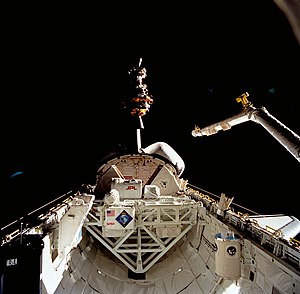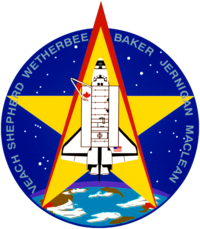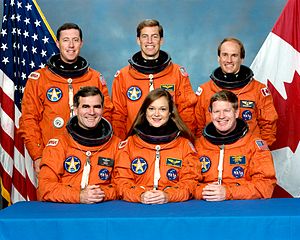


Columbia's payload bay, with the LAGEOS 2 satellite being deployed.
| |
| Names | Space Transportation System-52 |
|---|---|
| Mission type | Microgravity research LAGEOS 2 satellite deployment |
| Operator | NASA |
| COSPAR ID | 1992-070A |
| SATCAT no. | 22194 |
| Mission duration | 9 days, 20 hours, 56 minutes, 13 seconds |
| Distance travelled | 6,645,026 km (4,129,028 mi) |
| Orbits completed | 159 |
| Spacecraft properties | |
| Spacecraft | Space Shuttle Columbia |
| Launch mass | 113,460 kg (250,140 lb) |
| Landing mass | 97,574 kg (215,114 lb)[1] |
| Payload mass | 8,078 kg (17,809 lb) |
| Crew | |
| Crew size | 6 |
| Members |
|
| Start of mission | |
| Launch date | October 22, 1992, 17:09:39 UTC[2] |
| Rocket | Space Shuttle Columbia |
| Launch site | Kennedy Space Center, LC-39B |
| Contractor | Rockwell International |
| End of mission | |
| Landing date | November 1, 1992, 14:05:52 UTC |
| Landing site | Kennedy Space Center, SLF Runway 33 |
| Orbital parameters | |
| Reference system | Geocentric orbit[2] |
| Regime | Low Earth orbit |
| Perigee altitude | 300 km (190 mi) |
| Apogee altitude | 302 km (188 mi) |
| Inclination | 28.45° |
| Period | 90.60 minutes |
| Instruments | |
| |
 STS-52 mission patch  Back: Baker, Wetherbee, MacLean Front: Veach, Jernigan, Shepherd
← STS-47 (50)
STS-53 (52) →
| |
STS-52 was a Space Transportation System (NASA Space Shuttle) mission using Space Shuttle Columbia, and was launched on October 22, 1992.[3]
| Position | Astronaut [4] | |
|---|---|---|
| Commander | Second spaceflight | |
| Pilot | Second spaceflight | |
| Mission Specialist 1 | Second and last spaceflight | |
| Mission Specialist 2 | Third spaceflight | |
| Mission Specialist 3 | Second spaceflight | |
| Payload Specialist 1 | First spaceflight | |
| Position | Astronaut | |
|---|---|---|
| Payload Specialist 1 | Bjarni Tryggvason, CSA First spaceflight | |

Primary mission objectives were deployment of the Laser Geodynamics Satellite 2 (LAGEOS-2) and operation of the U.S. Microgravity Payload-1 (USMP-1). LAGEOS 2, a joint effort between NASA and the Italian Space Agency (ASI), was deployed on day 2 and boosted into an initial elliptical orbit by ASI's Italian Research Interim Stage (IRIS). The spacecraft's apogee kick motor later circularized LAGEOS 2 orbit at its operational altitude of 5,900 km (3,700 mi). The USMP-1, activated on day one, included three experiments mounted on two connected Mission Peculiar Equipment Support Structures (MPESS) mounted in the orbiter's cargo bay. USMP-1 experiments were: Lambda Point Experiment; Matériel pour l'Étude des Phénomènes Intéressant la Solidification sur eT en Orbite (MEPHISTO),[5] sponsored by the French agency Centre National d'Études Spatiales (CNES); and Space Acceleration Measurement System (SAMS).[3]
Secondary payloads: (1) Canadian experiment (CANEX-2), located in both the orbiter's cargo bay and middeck and which consisted of Space Vision System (SVS); Materials Exposure in Low-Earth Orbit (MELEO); Queen's University Experiment in Liquid-Metal Diffusion (QUELD); Phase Partitioning in Liquids (PARLIQ); Sun Photospectrometre Earth Atmosphere Measurement-2 (SPEAM-2); Orbiter Glow-2 (OGLOW-2); and Space Adaptation Tests and Observations (SATO).[6] A small, specially marked satellite, the Canadian Target Assembly (CTA), was deployed on day nine, to support SVS experiments. (2) ASP, featuring three independent sensors mounted on a Hitchhiker plate in the cargo bay - Modular Star Sensor (MOSS), Yaw Earth Sensor (YES) and Low Altitude Conical Earth Sensor (LACES), all provided by the European Space Agency (ESA).[7]
Other middeck payloads: Commercial Materials Dispersion Apparatus Instrument Technology Associates Experiments; Commercial Protein Crystal Growth experiment; Chemical Vapor Transport Experiment Heat Pipe Performance Experiment (CVTEHPPE); Physiological Systems Experiment (PSE) (involving 12 rodents); and Shuttle Plume Impingement Experiment (SPIE). The orbiter also was used as a reference point for calibrating an Ultraviolet Plume Instrument on an orbiting Strategic Defense Initiative Organization (SDIO) satellite.[8]
The Tank Pressure Control Experiment/Thermal Phenomena (TPCE/TP) was contained in a Getaway Special (GAS) canister in the orbiter's cargo bay.[9]
Some of the ashes of Star Trek creator Gene Roddenberry were also carried aboard the orbiter for the duration of the mission.[10]
NASA began a tradition of playing music to astronauts during the Project Gemini, and first used music to wake up a flight crew during Apollo 15. A special musical track is chosen for each day in space, often by the astronauts' families, to have a special meaning to an individual member of the crew, or in reference to the day's planned activities.[11]
| Day | Song | Artist/Composer | Played For |
|---|---|---|---|
| Day 2 | Wake Up Columbia | Crow Carroll | |
| Day 3 | Shake, Rattle and Roll | Big Joe Turner | Deployment of LAGEOS-II |
| Day 5 | The World is Waiting for the Sunrise | Les Paul and Mary Ford | |
| Day 6 | Birthday | The Beatles | Mike Baker's 39th Birthday |
| Day 7 | "Hawaiian music" | ||
| Day 8 | Mack the Knife | Bobby Darin | |
| Day 9 | Bang the Drum | Todd Rundgren | |
| Day 10 | Monster Mash | Bobby "Boris" Picket | To celebrate Halloween |
| Day 11 | Notre Dame Victory March | JSC employees & Notre Dame grads | James Wetherbee |
...Columbia also carried to space ashes of Star Trek creator, Gene Roddenberry
|
Space Shuttle Columbia (OV-102)
| ||
|---|---|---|
| Flights |
| |
| Status |
| |
| Related |
| |
|
| |||||||||||
|---|---|---|---|---|---|---|---|---|---|---|---|
| Completed (crews) |
| ||||||||||
| Cancelled |
| ||||||||||
| Orbiters |
| ||||||||||
| |||||||||||
|
| |
|---|---|
| January |
|
| February |
|
| March |
|
| April |
|
| May |
|
| June |
|
| July |
|
| August |
|
| September |
|
| October |
|
| November |
|
| December |
|
Launches are separated by dots ( • ), payloads by commas ( , ), multiple names for the same satellite by slashes ( / ). | |